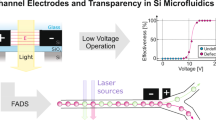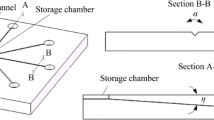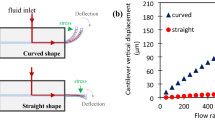Abstract
Conventionally fabricated silicon microfluidic systems with glass coverage were stabilized by a specially developed frame to withstand high-pressure drops of up to 500 bar. Velocity measurements were carried out with an optical non-intrusive measurement technique (μPIV) to characterize the flow in the microfluidic systems. High-pressure applications in microsystems differ compared to more conventional microfluidic applications especially in the higher Reynolds numbers up to 11,500, higher shear forces and the presence of hydrodynamic cavitation. In order to characterize the cavitation phenomena, a photo-optical cavitation measurement technique on the basis of a μPIV setup was applied to visualize the cavitation pattern. The flow of a T- and an orifice geometry were investigated. It was found out that hydrodynamic cavitation, which is a source of abrasion, influences the flow to a great extent and, in orifice geometries, also the volume flow. By applying a backpressure cavitation could be decreased and, at a sufficiently high backpressure, eliminated. Besides the photo-optical cavitation measurements, volume flow measurements could be used to determine the critical backpressure at which cavitation is restricted to the vena contracta in orifice microchannels. With the presented techniques, beginning with the micro fabrication process over the external stabilization up to the high-speed flow characterization, a concept of a high-pressure microfluidic system is introduced, which is suitable for a wide range of applications in research and process development in high-pressure microsystems.











Similar content being viewed by others
References
Arai M, Shimizu M, Hiroyasu H (1985) Breakup length and spray angle of high speed jet. In: 3rd International conference on liquid atomization and spray systems (ICLASS), London
Beinert S, Gothsch T, Kwade A (2012) Numerical evaluation of flow fields and stresses acting on agglomerates dispersed in high-pressure microsystems. Chem Eng Technol 35(11):1922–1930
Büttgenbach S, Balck A, Demming S, Lesche C, Michalzik M, Al-Halhouli AT (2009) Development of on chip devices for life science applications. Int J Eng 3:148–158
Capretto L, Carugo D, Mazzitelli S, Nastruzzi C, Zhang X (2013) Microfluidic and lab-on-a-chip preparation routes for organic nanoparticles and vesicular systems for nanomedicine applications. Adv Drug Deliv Rev 65(11–12):1496–1532. doi:10.1016/j.addr.2013.08.002
Chorny A, Zhdanov V (2012) Turbulent mixing and fast chemical reaction in the confined jet flow at large Schmidt number. Chem Eng Sci 68(1):541–554. doi:10.1016/j.ces.2011.10.015
Finke JH, Schur J, Richter C, Gothsch T, Kwade A, Büttgenbach S, Müller-Goymann CC (2012) The influence of customized geometries and process parameters on nanoemulsion and solid lipid nanoparticle production in microsystems. Chem Eng J 209:126–137. doi:10.1016/j.cej.2012.07.115
Gothsch T, Finke JH, Beinert S, Lesche C, Schur J, Büttgenbach S, Müller-Goymann C, Kwade A (2011) Effect of microchannel geometry on high-pressure dispersion and emulsification. Chem Eng Technol 34(3):335–343
Gravesen P, Branebjerg J, Jensen OS (1993) Microfluidics-a review. J Micromech Microeng 3(4):168
Håkansson A, Fuchs L, Innings F, Revstedt J, Bergenståhl B, Trägårdh C (2010) Visual observations and acoustic measurements of cavitation in an experimental model of a high-pressure homogenizer. J Food Eng 100(3):504–513. doi:10.1016/j.jfoodeng.2010.04.038
Lee C-Y, Chang C-L, Wang Y-N, Fu L-M (2011) Microfluidic mixing: a review. Int J Mol Sci 12(5):3263–3287
Lesche C, Gothsch T, Kwade A, Büttgenbach S (2011) Development of a dispersion micro-element for pharmaceutical screening applications: material and fabrication. In: Proceedings of MST Kongress 2011, Darmstadt, Germany, pp 642–645
Li H, Olsen MG (2006a) MicroPIV measurements of turbulent flow in square microchannels with hydraulic diameters from 200 μm to 640 μm. Int J Heat Fluid Flow 27(1):123–134
Li H, Olsen MG (2006b) Examination of large-scale structures in turbulent microchannel flow. Exp Fluids 40:733–743. doi:10.1007/s00348-006-0110-4
Li H, Ewoldt R, Olsen MG (2005) Turbulent and transitional velocity measurements in a rectangular microchannel using microscopic particle image velocimetry. Exp Thermal Fluid Sci 29(4):435–446
Martynov S (2005) Numerical simulation of the cavitation process in diesel fuel injectors. University of Brighton, Brighton
Mishra C, Peles Y (2005) Flow visualization of cavitating flows through a rectangular slot micro-orifice ingrained in a microchannel. Phys Fluids 17(11):1–14
Phipps LW (1974) Cavitation and separated flow in a simple homogenizing valve and their influence on the break-up of fat globules in milk. J Dairy Res 41(01):1–8. doi:10.1017/S0022029900014849
Richter C, Stegemann D, Vierheller A, Gothsch T, Finke JH, Kwade A, Müller-Goymann CC, Dietzel A, Büttgenbach S (2013) Innovative process chain for the development of wear resistant 3D metal microsystems. Microelectron Eng 110(0):392–397. doi:10.1016/j.mee.2013.02.078
Salvador FJ, Martínez-López J, Caballer M, De Alfonso C (2013) Study of the influence of the needle lift on the internal flow and cavitation phenomenon in diesel injector nozzles by CFD using RANS methods. Energy Convers Manag 66(0):246–256. doi:10.1016/j.enconman.2012.10.011
Sato K, Saito Y (2001) Unstable cavitation behavior in a circular-cylindrical orifice flow. In: Fourth international symposium on cavitation: CAV 2001, California Institute of Technology, Pasadena, CA
Sou A, Hosokawa S, Tomiyama A (2007) Effects of cavitation in a nozzle on liquid jet atomization. Int J Heat Mass Transf 50(17–18):3575–3582. doi:10.1016/j.ijheatmasstransfer.2006.12.033
Suh HK, Lee CS (2008) Effect of cavitation in nozzle orifice on the diesel fuel atomization characteristics. Int J Heat Fluid Flow 29(4):1001–1009. doi:10.1016/j.ijheatfluidflow.2008.03.014
Zhdanov V, Chorny A (2011) Development of macro- and micro-mixing in confined flows of reactive fluids. Int J Heat Mass Transf 54(15–16):3245–3255. doi:10.1016/j.ijheatmasstransfer.2011.04.006
Acknowledgments
The authors gratefully acknowledge the DFG for financial support within the DFG research group 856 “Microsystems for particulate life-science-products” (mikroPART) and the mikroPART group. One of the authors (S. Bü.) gratefully acknowledges the financial support of the Volkswagen Foundation.
Author information
Authors and Affiliations
Corresponding author
Rights and permissions
About this article
Cite this article
Gothsch, T., Schilcher, C., Richter, C. et al. High-pressure microfluidic systems (HPMS): flow and cavitation measurements in supported silicon microsystems. Microfluid Nanofluid 18, 121–130 (2015). https://doi.org/10.1007/s10404-014-1419-6
Received:
Accepted:
Published:
Issue Date:
DOI: https://doi.org/10.1007/s10404-014-1419-6




